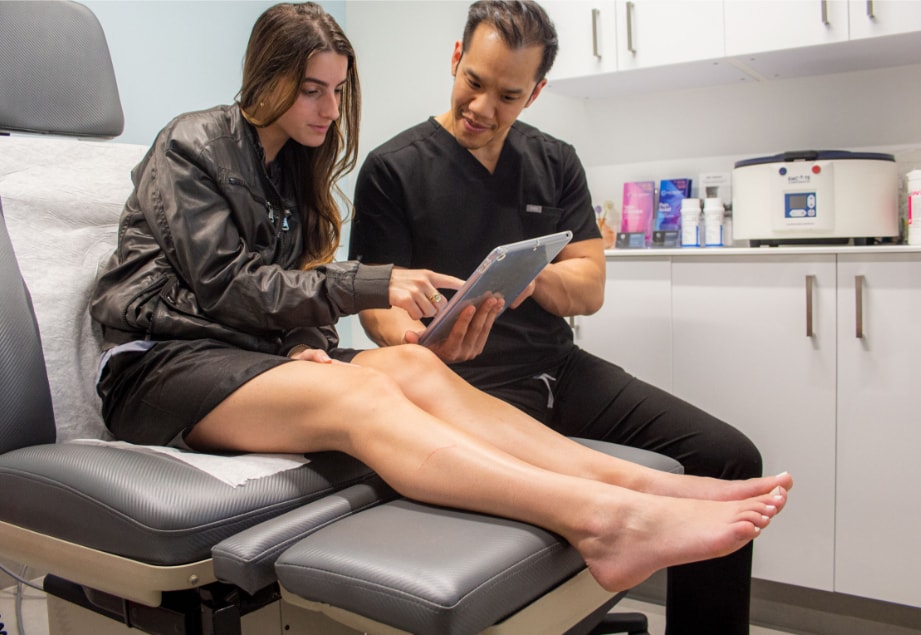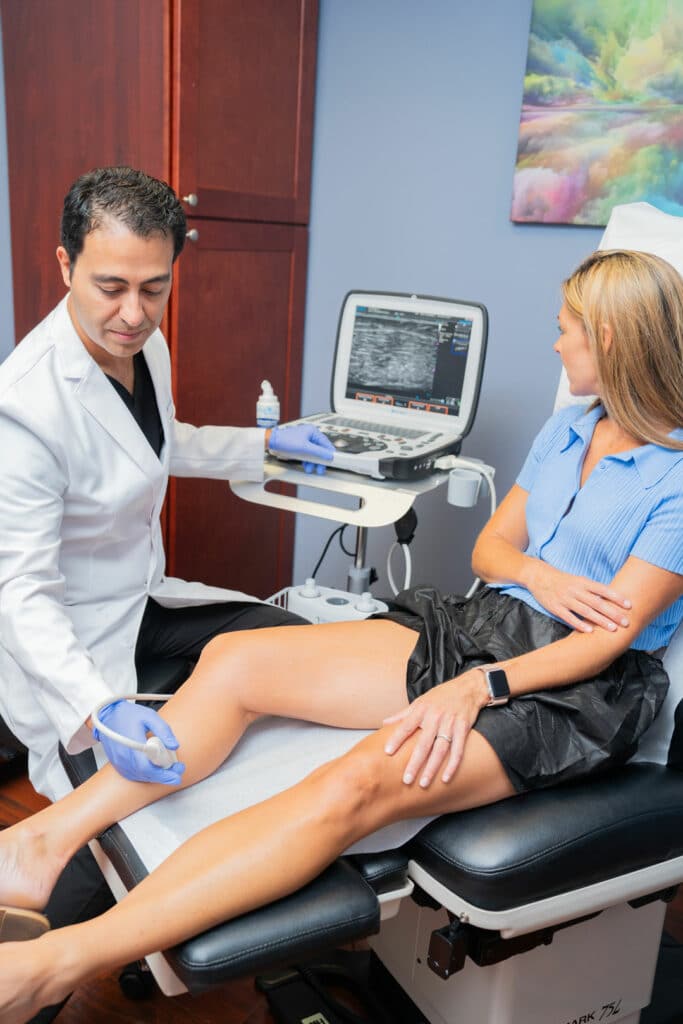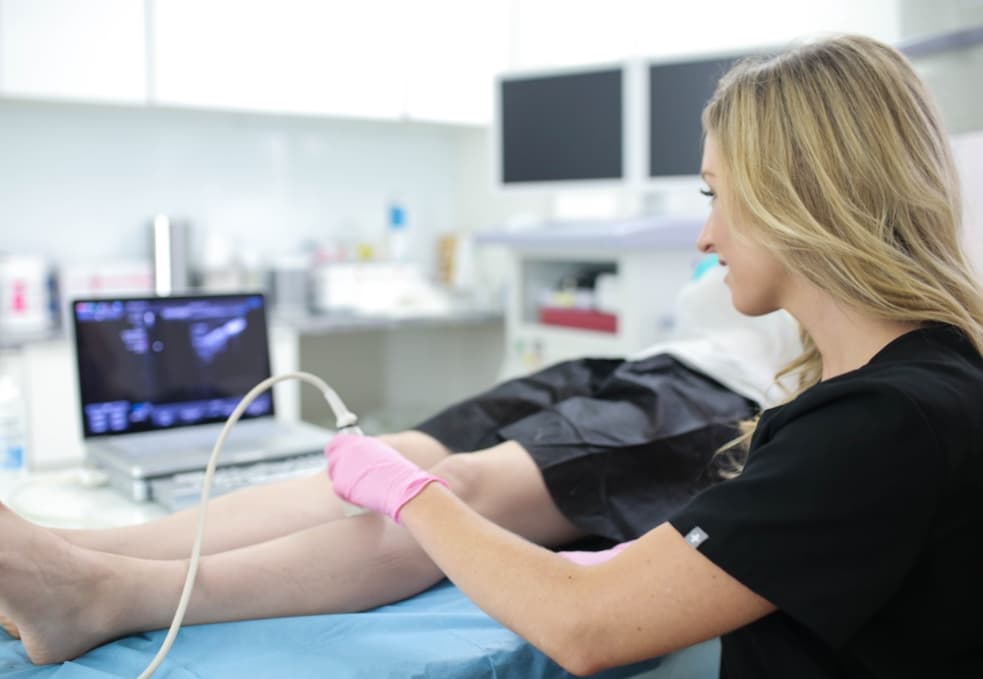What is chronic venous insufficiency?
If you’re wondering how to reverse venous insufficiency, you need some background on this unique medical condition. Venous insufficiency is one of the world’s most underdiagnosed medical conditions, so it’s important to familiarize yourself with the beginning stages of varicose vein and chronic venous insufficiency.
Chronic venous insufficiency is a circulatory disorder triggered by the collapse of vein valves. Healthy veins contain valves that facilitate smooth blood circulation to the heart. They open up to allow blood to flow towards the heart, but they prevent blood from flowing backward due to gravity. When the vein valves collapse or malfunction, blood flows backward due to gravity and accumulates in the leg veins. The continued accumulation of blood in leg veins eventually leads to spider veins, varicose veins, and other vein problems.

What are the signs and symptoms of vein disease?
Chronic venous insufficiency is one of the most underdiagnosed conditions because its initial symptoms are extremely mild. The beginning stages of varicose veins may involve mild leg swelling, leg heaviness, leg pain, restless leg syndrome, and frequent leg cramps, usually at night or after long periods of sitting or standing still. The symptoms worsen when more blood accumulates in the leg veins, which is usually at the end of the day or after long periods of sitting or standing still.
Spider veins and varicose veins are the most visible signs of vein disease. Most people visit vein doctors or physicians when they notice dense spider veins and varicose veins on their legs. Spider veins are dense clusters of damaged blood vessels that remain under the skin’s surface, and varicose veins are damaged blood vessels that bulge out of the skin’s surface, usually looking like a mass of twisted and tangled ropes.
If left untreated, chronic venous insufficiency can eventually lead to numerous harsh complications, such as skin discoloration, leg ulcers, and deep vein thrombosis (blood clots in leg veins). Leg ulcers occur because the wounds in your legs can’t heal without proper blood circulation. And deep vein thrombosis occurs when the accumulated blood in your leg veins clots, increasing the risk of a potentially fatal pulmonary embolism.
Can you reverse chronic venous insufficiency?
You can’t reverse chronic venous insufficiency. Once a vein valve is damaged or collapsed, it can’t be healed, so there’s no way to cure or reverse vein disease. You can take some steps to push some of the accumulated blood from the leg veins to the heart, which will alleviate some of the worst symptoms of vein disease, but the relief is temporary. The only way to treat chronic venous insufficiency is by collapsing or destroying the diseased vein, so the accumulated blood will reroute into healthier leg veins.
In the next section, we describe how to treat a collapsed vein valve. But before we get to that section, let’s look at some home remedies to prevent vein disease from worsening:
- Wear compression stockings regularly to push the accumulated blood to the heart.
- Elevate your legs above your heart’s level to push the accumulated blood to the heart.
- Participate in low-intensity cardiovascular exercises that engage your calf muscles, such as running, swimming, cycling, and yoga, to improve overall blood flow to the heart.
- Don’t sit or stand still for long periods to prevent blood from accumulating in the leg veins.
So, how to treat a collapsed vein valve?
So, you now understand the root cause of most vein problems, how chronic venous insufficiency happens, and how the symptoms of vein disease can be reduced. While you can’t reverse or cure chronic venous insufficiency, modern minimally invasive procedures can treat the condition. Our vein doctors perform thorough duplex ultrasound tests to visualize the blood flow in your leg veins, diagnose vein disease, and curate a personalized vein treatment plan.
We only offer minimally invasive spider vein and varicose vein treatments because they’re safer, more effective, and more convenient than vascular surgeries. Minimally invasive procedures are in-office sessions that conclude within an hour and don’t involve major excisions, hospitalization, or general anesthesia. The treatment concludes within an hour, following which you can resume your daily activities and work immediately. Furthermore, we always address the root cause of your vein problems to prevent vein disease recurrence.
Below, we describe the best minimally invasive collapsed vein treatments.
Endovenous Radiofrequency Ablation
Radiofrequency ablation is a procedure that involves using thermal energy to treat chronic venous insufficiency. The vein doctor makes a small incision on the skin’s surface, inserts a catheter to generate thermal energy, and collapses the diseased vein, automatically rerouting the accumulated blood into healthier leg veins.
Endovenous Laser Ablation
Endovenous laser ablation is one of the first minimally invasive treatments for chronic venous insufficiency. The vein doctor makes a small incision on the skin’s surface to insert a specialized endovenous laser that generates laser energy and destroys the diseased vein, rerouting the accumulated blood into healthier leg veins to restore optimal blood circulation.
VenaSeal Closure System
VenaSeal is a unique minimally invasive procedure for chronic venous insufficiency. The vein doctor injects a medical-grade adhesive into the diseased saphenous vein to seal its walls shut, turning it into a hardened tissue eventually reabsorbed by the body. The accumulated blood reroutes into healthier leg veins.
What kind of doctor treats chronic venous insufficiency?
A phlebologist is a physician responsible for the diagnosis and treatment of chronic venous insufficiency. But phlebologists are colloquially known as vein doctors or vein specialists. When looking for a reliable vein doctor, you must focus on board-certified vein doctors specializing in the latest minimally invasive procedures, such as radiofrequency ablation and sclerotherapy. Please schedule an appointment to explore your vein treatment options.




